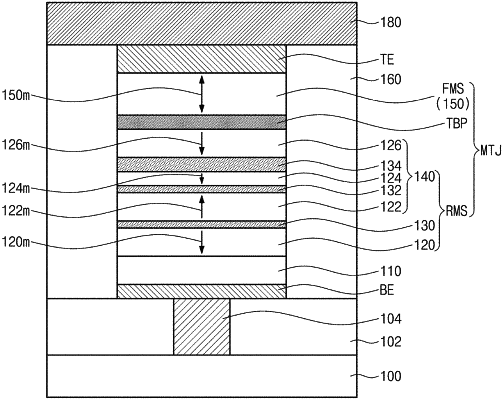| CPC H01L 43/02 (2013.01) [H01F 10/329 (2013.01); H01F 10/3254 (2013.01); H01F 10/3268 (2013.01); H01F 10/3286 (2013.01); H01L 27/228 (2013.01); G11C 11/161 (2013.01); G11C 11/1659 (2013.01); H01L 43/10 (2013.01); H01L 43/12 (2013.01)] | 17 Claims |

|
1. A magnetic memory device comprising:
a reference magnetic structure including a first pinned pattern, a second pinned pattern including magnetic patterns and non-magnetic patterns, which are alternately stacked, and an exchange coupling pattern between the first pinned pattern and the second pinned pattern, the first pinned pattern directly contacting a seed pattern and the exchange coupling pattern;
a free magnetic structure; and
a tunnel barrier pattern between the reference magnetic structure and the free magnetic structure,
wherein the second pinned pattern is between the first pinned pattern and the tunnel barrier pattern,
the first pinned pattern is a ferromagnetic pattern, the ferromagnetic pattern consisting of a single ferromagnetic element,
wherein the magnetic patterns include,
a first ferromagnetic pattern between the exchange coupling pattern and the tunnel barrier pattern, and
a second ferromagnetic pattern between the first ferromagnetic pattern and the tunnel barrier pattern, and
wherein the non-magnetic patterns include,
a first non-magnetic pattern between the first ferromagnetic pattern and the second ferromagnetic pattern,
wherein the exchange coupling pattern anti-ferromagnetically couples the first ferromagnetic pattern to the first pinned pattern,
wherein each of the first pinned pattern and the first ferromagnetic pattern have a thickness in a direction perpendicular to an interface between the tunnel barrier pattern and the free magnetic structure, and
wherein the thickness of the first pinned pattern is greater than or equal to the thickness of the first ferromagnetic pattern.
|